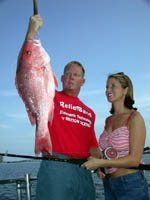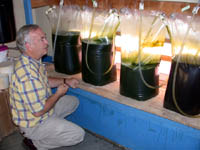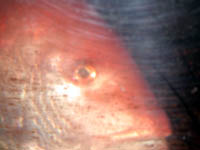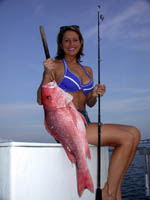
|
Features
|
|
|
|
Books
|
|
|
|
Fun & Games
|
|
|
|
Contact Us
|
|
|
John's Journal... Entry 232, Day 4
SNAPPER BONANZA
The Future of Red Snapper
 Editor's
Note: The recovery of red snapper in the Gulf of Mexico and possibly worldwide
may occur much quicker than previously predicted, thanks to a small group
of scientists at the Claude Peteet Mariculture Center in Gulf Shores,
Alabama. New scientific breakthroughs in artificially spawning snapper,
producing microscopic-sized food for baby snapper, training snapper to
eat commercially-prepared food, creating an artificial habitat that speeds
up the reproduction cycle of the red snapper and constructing a new salt-water
pipeline from the Gulf of Mexico to the Mariculture Center may result
in the Center's producing 100,000 red snapper per year for restocking
and research within the next five years.
Editor's
Note: The recovery of red snapper in the Gulf of Mexico and possibly worldwide
may occur much quicker than previously predicted, thanks to a small group
of scientists at the Claude Peteet Mariculture Center in Gulf Shores,
Alabama. New scientific breakthroughs in artificially spawning snapper,
producing microscopic-sized food for baby snapper, training snapper to
eat commercially-prepared food, creating an artificial habitat that speeds
up the reproduction cycle of the red snapper and constructing a new salt-water
pipeline from the Gulf of Mexico to the Mariculture Center may result
in the Center's producing 100,000 red snapper per year for restocking
and research within the next five years.
 Vernon
Minton, the director of Alabama's Marine Resources Division, and his team
can take the knowledge they've learned from spawning and rearing snapper
in 1000-gallon salt-water tanks and use this information to try to duplicate
the same results in salt-water ponds. If these scientists can raise fingerling
snapper in the laboratory, place these snapper in salt-water ponds, feed
them artificially and grow them to a size that will allow them to survive
in the wild, they drastically can speed up the recovery of snapper stocks
worldwide. Minton emphasizes that, "We'll have researchers monitoring
the fish we stock.
Vernon
Minton, the director of Alabama's Marine Resources Division, and his team
can take the knowledge they've learned from spawning and rearing snapper
in 1000-gallon salt-water tanks and use this information to try to duplicate
the same results in salt-water ponds. If these scientists can raise fingerling
snapper in the laboratory, place these snapper in salt-water ponds, feed
them artificially and grow them to a size that will allow them to survive
in the wild, they drastically can speed up the recovery of snapper stocks
worldwide. Minton emphasizes that, "We'll have researchers monitoring
the fish we stock.
 We
need to know:
We
need to know:
* "whether the juvenile snapper we've stocked stay on the reef where we've
stocked them,
* "whether they've grown on that reef to larger sizes,
* "where they go after they leave the stocking reef,
* "whether or not they've spawned,
* "where they have been caught,
* "how long they have lived and
* "how fast they have grown."
 If
the research at the Mariculture Center continues to develop at the present
rate, scientists will produce 4- to 6-inch snapper for restocking within
one year and will tag these snapper before releasing them to help scientists
and anglers identify them. "We're currently considering using a dye that
we can inject into the snapper's cheek that will let our scientists and
the general public identify these fish when they're caught," Minton comments.
"Also scuba divers can quickly and easily identify the snapper while they're
monitoring the fish's growth and movement on the reefs. Our research indicates
that triggerfish that also live on the reefs with the red snapper will
eat the traditional plastic fish tags placed on the side of the fish.
Too, the introduction of those tags is so traumatic that quite a few small
snapper will die if tagged this way. Everyone has invested too much in
this program to lose fish because of tagging."
If
the research at the Mariculture Center continues to develop at the present
rate, scientists will produce 4- to 6-inch snapper for restocking within
one year and will tag these snapper before releasing them to help scientists
and anglers identify them. "We're currently considering using a dye that
we can inject into the snapper's cheek that will let our scientists and
the general public identify these fish when they're caught," Minton comments.
"Also scuba divers can quickly and easily identify the snapper while they're
monitoring the fish's growth and movement on the reefs. Our research indicates
that triggerfish that also live on the reefs with the red snapper will
eat the traditional plastic fish tags placed on the side of the fish.
Too, the introduction of those tags is so traumatic that quite a few small
snapper will die if tagged this way. Everyone has invested too much in
this program to lose fish because of tagging."
AMRD will ask fishermen to notify the department when and where they catch snapper with blue streaks in their cheeks and tell the department how much the snapper weigh and the general condition of the fish. This tagging system may begin next year.
To learn more about this program at the Marine Resources Division, e-mail Minton at rvminton@gulftel.com, and you also can visit www.dcnr.state.al.us/mr/cpmc.htm on the Web.
TOMORROW: SNAPPER AS AN AQUACULTURE FISH
Check back each day this week for more about SNAPPER BONANZA ...
Day 1 - The Future Has Arrived
Day 2 - The Problem With Raising Captive
Red Snapper: Producing Food For the Fry
Day 3 - Two Ways To Spawn Snapper: Artificially
and By Creating Habitat
Day 4 - The Future of Red Snapper
Day 5 - Snapper As An Aquaculture Fish